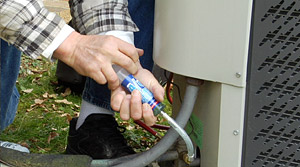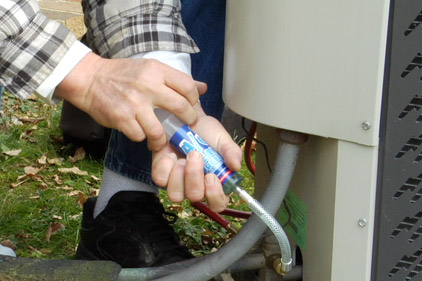
|
| A/C Leak Freeze (shown) is being injected into a refrigerant line to seal leaks. |
There are many reasons for wanting to stop refrigerant leaks in HVAC mechanical equipment. Some of the most obvious are partial or total loss of cooling capacity, decrease in efficiency, system damage, costly repairs and cleanup, etc. The list goes on and on. In many cases, leaks bring on additional power consumption and more downtime, two things that HVAC contractors’ customers don’t like and don’t want.
HVAC contractors do their best to educate customers on the problems of leaky refrigerant. On his web blog, Aaron York Jr. of Aaron York’s Quality Air, Indianapolis, has referred to checking for leaks as a means for reducing a carbon footprint. “Fix refrigerant leaks,” York wrote. “Refrigerant is expensive, and when it leaks, it can cause huge harm to the environment. Additionally, if moisture reacts with the refrigerant, it can cause damage to your compressor and other parts of your air conditioner. If you notice any refrigerant leaks, get them fixed right away!”
Leaks don’t discriminate either. They can show up in large commercial and industrial chillers and freezers as well as smaller residential refrigeration units or air conditioners. But the most obvious way to prevent leaks in any system is through proper installation, service, and routine maintenance. Prevention is always the best way to precede detection. However, even proper maintenance can’t always stop a component from leaking, which is why detection methods are so vital.
Sleuthing
What was once the sight and sniff method for leak detection has now been replaced by easier, more reliable methods, thanks to technology and some plain common sense. Soap, ultraviolet (UV) light, and electronic testing can be effective and accurate ways to test. One such effective way is by using hand-held leak detectors. These detectors can sense excess presence of the gas, which may also carry adverse health effects.
“The traditional way to detect leaks is to inject dye into the system and locate the leaks with a black tracer light,” said Brian Kemp of A/C Leak Freeze. “Fluorescent dyes can be used with refrigerants. The dye remains at all the leaks, leading to easy identification of damaged areas in HVAC systems.”
Another way to detect leaks is the bubble leak method. In this method, gas is blown over the piping and components in a controlled environment. When a leak is present, pressure bubbles can be seen coming from the leak.
But any method can be improved upon, given the changing component technology. “Sealing technology has improved greatly, and there are new ways to detect leaks,” said Kemp.
He noted that there is currently a leak-sealing process that is time- and money-saving, especially for small leaks in HVACR systems. “When a system is not cooling as it should, the first cause is mostly a low level of coolant due to a small leak,” he said. “These leaks can come from various sources like corrosion and in the pipe joints.
Besides having a competent and qualified service technician to maintain and service refrigeration and air conditioning systems, Kemp said that currently there are leak-sealing products — including one manufactured by his company — that work well in any HVACR system.
“One new technique is not to go through the traditional dye and seek process but to inject the sealant directly into the system and see if the performance of the systems returns,” he said. This process will have the system back to OMG performance in 15 minutes or so.”
“Let’s face it, a new approach to leak detection may result in a new cash flow line for contractors who have annual service programs with guarantees, etc.”
For more information on A/C Leak Freeze, visit www.leakfreeze.com.
Publication date: 04/23/2012


Report Abusive Comment